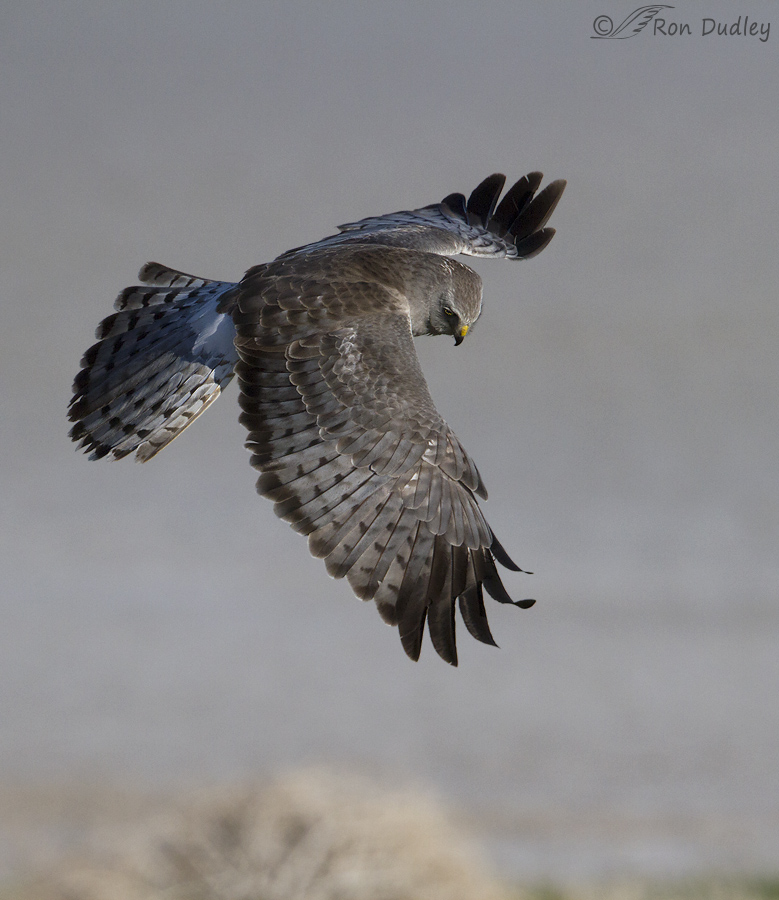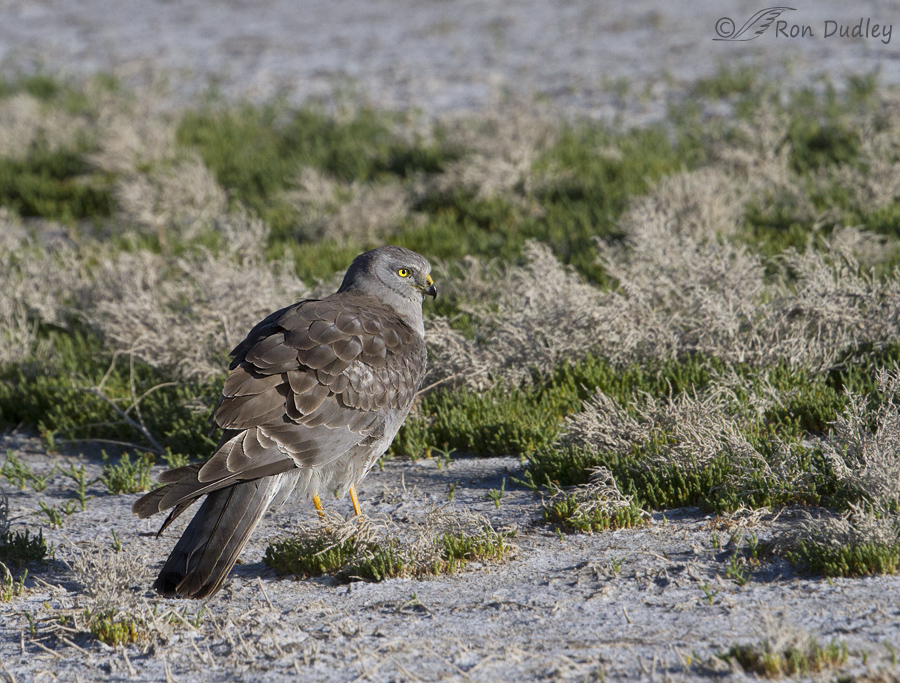The eight minutes I spent photographing this male Northern Harrier in flight were both exhilarating and frustrating to the extreme. I’ll set the stage as best I can.
Just after dawn two days ago we were on the causeway and headed for Antelope Island when we encountered this male northern Harrier hunting the north side of the road. There was a moderate north wind and the harrier was traveling east which meant that he had to face northeast as he rode the air currents obliquely and very slowly in the direction he wanted to go, barely flapping his wings as he hunted very low over the edge of the causeway. I turned around, rushed to get ahead of him and waited until he came into range and then fired away. I did this again and again, thinking my activity might spook him but it didn’t (quite unusual for a harrier). In fact he almost completely ignored us as he hunted. It was very exciting to spend this much time with a harrier in flight.
1/5000, f/7.1, ISO 500, Canon 7D, Canon EF500mm f/4L IS II USM +1.4 tc, not baited, set up or called in
But it was also frustrating to the extreme. Because of the quartering wind the harrier was mostly kiting in the same flight posture (wings held horizontally), facing the same direction (mostly away from me) and looking down as it hunted. That wind direction, sun angle, flight angle of attack and hunting activity meant that the eye was nearly always shaded for the entire 8 minutes. A rear/side-view with the wings held horizontally and the eye impossible to see well just doesn’t cut the mustard for me.
But out of the 110 shots I took of him in flight there were a very few like this one that I thought were interesting. The bird had momentarily dipped his wings to light up most of the dorsal surface and there’s just enough light on the face to (barely) reveal the eye. I like the overall effect of the lighting, the spread of the tail and with this crop we get a hint of the brown and green vegetation and how low the harrier was hunting.
1/4000, f/7.1, ISO 500, Canon 7D, Canon EF500mm f/4L IS II USM +1.4 tc, not baited, set up or called in
Once during those eight minutes he caught prey (presumably a vole, it can’t be seen at his feet in this shot) and gobbled it down in just a few seconds. This image gives a different look at the bird and the habitat it was hunting. The mud flats of the Great Salt Lake begin in the upper background of the photo.
Ron




Your aim and timing with the 500 is impeccable, blown away by this and the other flight shots. I would love to see some more shots of the prairie falcon if you have any.
Thanks very much, James. I plan on posting a Prairie Falcon soon but it won’t be in flight.
I like the first one very much. The coloring on the rump is lovely.
Thanks Ron. Seeing the wing feathers spread in that fashion you can almost feel the bird feeling the wind. Great pic.
I don’t have anything to add to the accolades already provided. I just come here to gawk. Sigh. What a beautiful bird! If the images in the field guides looked like this, everyone would be a birder.
Thank you, Ron!
“If the images in the field guides looked like this, everyone would be a birder.”
I had two immediate reactions to that part of your comment, Wally. First I chuckled out loud. Then I thought about it some more and realized what a (well phrased) compliment it was. You made my day…
Wow! What an excellent shot! It is a unique view, as if you are flying beside him.
Jane, at times I felt like I was “flying with him” too as I watched him in flight through my lens. I think the fact that I was eye level with him contributed to that feeling.
Both shots are wonderful, but the first one is amazing!…never saw anything like it (is there some way you can pipe your rejects onto my evil iPad???)
Believe me, Patty – you wouldn’t want my rejects. I got a lot of them this morning and most of them are pretty sad.
WHAT a privilege for you – and us to see. Thank you.
And, can I recommend that you take fewer self critical pills with your morning coffee? Perhaps just one less. Enough still left in your system to keep encouraging your search for photographic nirvana, while leaving a sense of achievement for the shots you do get – and nail.
Dearest Elephant’s Child
Re: Ron’s pills
I echo your sentiments!
Made me smile, Elephant’s Child. I agree, it’s a delicate balance between being too critical and striving for excellence. Then you throw in the “matter of taste” element and things become even more murky. But I’ll try taking fewer of those pills. I hate taking pills of any kind anyway…
Beautiful photo…the posture of the harrier makes it even more special!
Thanks, Susan. I like that flight posture too.
the Harrier in flight is awesome, Ron. Well Done. What a great way to spend a morning.
Yeah, it was fun, Angela. A little depressing though when I was culling images and so many of them had to be dumped…
That has to be the most spectacular image of a bird I’ve ever seen!!! Amazing!!!!
Thank you very much, Suze.
I love that first photo. The lighting is wonderful, as is the fact you can tell that he is looking for something down below. The second photo shows how big these birds are – didn’t quite realize that because I’ve not seen them up that close. t wish we could see Harriers all year long (we just get them in winter here).
Susan, We get them year-round but they’re sure easier to photograph in winter. This guy was an exception.
Very nice shots Ron!! Your ‘Gray Ghost’ looks darker than ours here in the east.
I know this is probably not the place to ask this question, but I have to ask anyway. When you take 110 images what is going through your mind when you sit down and decide what to cull? Do you have a number that you will keep regardless or do you decide with other parameters that you have categorized?
I’m getting to the point when I take 40,80 or more shots of a subject, that I have to resist dumping them all into the computer and saying I’ll cull them this winter. So, this is a selfish question since I am looking for a means to deal with the increasing number of my images. I use Aperture to store my images, and really enjoy that software, BUT my number is getting huge, and having 3 backups simple allows me to be lazy about this problem.
Sorry, just had to try and get your input because I respect you and the way you go about getting your images.
Dick, With very few exceptions I’ll only keep images that fit into one or more of these categories – 1. images that are technically pretty good or better, 2. images that show interesting behavior or physical characteristics, or 3. images that I think might have some use on my blog one day, for whatever reason (this one is hard to predict). Once in a while I’ll keep an image just because I like it even though it doesn’t fit into any of those categories.
I must admit that many of my older images should be re-culled – my standards have improved over the years…
I know me and if my culling backlog gets to big then the task becomes too daunting and then I procrastinate which only makes things worse. So I try very, very hard to keep reasonably current on my culling. I’ve got some to do right now…
Beautiful capture Ron ! Your patience paid off.
Thank you, John. I’m not sure how patient I was though…
The flight shot is great. So interesting to be able to see all of the individual feathers on the right wing. It’s beautiful to look at, and is also a textbook resource for those interested in the details of wing structure. Thanks.
Jeff, I thought the same thing about the good look at the feather patterns of the wing. Thanks.
What beautiful shots! Thanks for sharing Ron!
Charlotte
Thanks, Charlotte.
Because you hung in despite your frustration, we all get to share your exhilaration – thanks! Very interesting to be able to view the mud flats, and I love the photo of the Northern Harrier in flight…
Thank you, Alison.